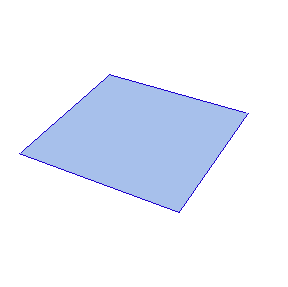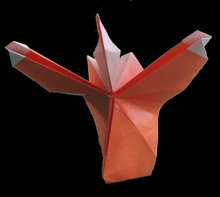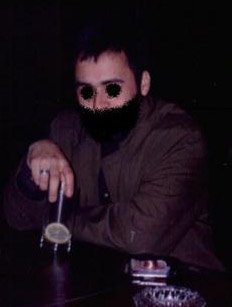

Once in a while I think about the amount of time and energy I spend on this activity, and even when I repeat to me that this is not merely a hobby but a form of art, I can't free my mind of considering how much of selfishness or personal satisfaction moves me to do it, how much of self discipline, hard work and dedication, instead of a more social perspective, oriented to others. Maybe to compensate that in a way we participate on workshops, teaching the basics figures spreading this craft as alternatives of fun, education and discipline.

 Tells the legend about a deadly sick man who made 1.000 traditional origami cranes, to honor the sacred bird, famous because its longevity and purity. In appreciation for that it gave him health and a long life. Then tradition says sick persons that fold this number can ask for the wish of recovery, health and a long life. As a way to keep her hope of healing and be able for running again, she devoted herself to fold them with any piece of paper that she could get on the Hospital and soon she decided to ask for the other victims of the war and for World Peace also. Unfortunately she died on October 25th 1955, after 14 months of
Tells the legend about a deadly sick man who made 1.000 traditional origami cranes, to honor the sacred bird, famous because its longevity and purity. In appreciation for that it gave him health and a long life. Then tradition says sick persons that fold this number can ask for the wish of recovery, health and a long life. As a way to keep her hope of healing and be able for running again, she devoted herself to fold them with any piece of paper that she could get on the Hospital and soon she decided to ask for the other victims of the war and for World Peace also. Unfortunately she died on October 25th 1955, after 14 months of
sickness, she made 644 cranes.
It is told that her friends at school completed the remaining 356 and left all the 1.000 with her on her grave. Since then, every August 6th, thousands of people gather to fold and hang cranes in memory of little Sadako and to claim for Peace and the end of War in the world.
To us who practices origami, to fold a traditional crane becomes a very simple and maybe trivial thing; however, to leave this example and call unattended is simply a sin, out of any logic or behavior. In our continent, in the city of Rosario, Argentina, thanks to tireless Meri and her group, since 9 years they gather and hang cranes remembering Sadako and asking for peace, last year they reached more than 20.000 colorful cranes!
This year, here on Santiago (Chile), this Saturday August 2nd, we will do also, the meeting will be on Plaza Mori, Bellavista, at midday, to remember the cry written on Sadako's Memorial on 1958:
“This is our Cry, this is our Pray: Peace in the World!”
I hope to join my friend on Rosario this year and help her in any way I can.

Links:
Call: Mil Grullas por la Paz Santiago, Chile, 2 de Agosto (Facebook).
Project: Mil Grullas Por la Paz Rosario Argentina, 6 de Agosto
Project: Sadako.com
 Tells the legend about a deadly sick man who made 1.000 traditional origami cranes, to honor the sacred bird, famous because its longevity and purity. In appreciation for that it gave him health and a long life. Then tradition says sick persons that fold this number can ask for the wish of recovery, health and a long life. As a way to keep her hope of healing and be able for running again, she devoted herself to fold them with any piece of paper that she could get on the Hospital and soon she decided to ask for the other victims of the war and for World Peace also. Unfortunately she died on October 25th 1955, after 14 months of
Tells the legend about a deadly sick man who made 1.000 traditional origami cranes, to honor the sacred bird, famous because its longevity and purity. In appreciation for that it gave him health and a long life. Then tradition says sick persons that fold this number can ask for the wish of recovery, health and a long life. As a way to keep her hope of healing and be able for running again, she devoted herself to fold them with any piece of paper that she could get on the Hospital and soon she decided to ask for the other victims of the war and for World Peace also. Unfortunately she died on October 25th 1955, after 14 months ofsickness, she made 644 cranes.
It is told that her friends at school completed the remaining 356 and left all the 1.000 with her on her grave. Since then, every August 6th, thousands of people gather to fold and hang cranes in memory of little Sadako and to claim for Peace and the end of War in the world.
To us who practices origami, to fold a traditional crane becomes a very simple and maybe trivial thing; however, to leave this example and call unattended is simply a sin, out of any logic or behavior. In our continent, in the city of Rosario, Argentina, thanks to tireless Meri and her group, since 9 years they gather and hang cranes remembering Sadako and asking for peace, last year they reached more than 20.000 colorful cranes!
This year, here on Santiago (Chile), this Saturday August 2nd, we will do also, the meeting will be on Plaza Mori, Bellavista, at midday, to remember the cry written on Sadako's Memorial on 1958:
“This is our Cry, this is our Pray: Peace in the World!”
I hope to join my friend on Rosario this year and help her in any way I can.

Links:
Call: Mil Grullas por la Paz Santiago, Chile, 2 de Agosto (Facebook).
Project: Mil Grullas Por la Paz Rosario Argentina, 6 de Agosto
How to make an Origami Traditional Crane




1 comment:
The popular comment layout is common, so it is easily recognized when scanning to post a comment. If the comment section is in a different format, then I am going to spend more time trying to decipher what everything means.
online jobs
Post a Comment